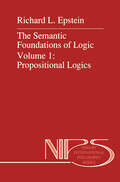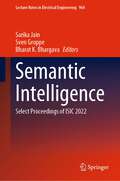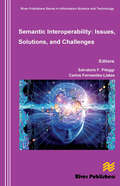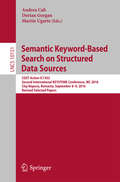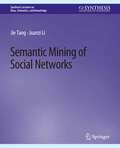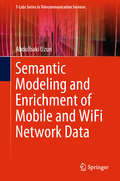- Table View
- List View
The Semantic Foundations of Logic Volume 1: Propositional Logics (Nijhoff International Philosophy Series #35)
by R.L. EpsteinThis book grew out of my confusion. If logic is objective how can there be so many logics? Is there one right logic, or many right ones? Is there some underlying unity that connects them? What is the significance of the mathematical theorems about logic which I've learned if they have no connection to our everyday reasoning? The answers I propose revolve around the perception that what one pays attention to in reasoning determines which logic is appropriate. The act of abstracting from our reasoning in our usual language is the stepping stone from reasoned argument to logic. We cannot take this step alone, for we reason together: logic is reasoning which has some objective value. For you to understand my answers, or perhaps better, conjectures, I have retraced my steps: from the concrete to the abstract, from examples, to general theory, to further confirming examples, to reflections on the significance of the work.
Semantic Grid: Model, Methodology, and Applications (Advanced Topics in Science and Technology in China)
by Zhaohui Wu Huajun ChenSemantic Grid: Model, Methodology, and Applications introduces to the science, core technologies, and killer applications. First, scientific issues of semantic grid systems are covered, followed by two basic technical issues, data-level semantic mapping, and service-level semantic interoperating. Two killer applications are then introduced to show how to build a semantic grid for specific application domains. Although this book is organized in a step by step manner, each chapter is independent. Detailed application scenarios are also presented. In 1990, Prof. Wu invented the first KB-system tool, ZIPE, based on C on a SUN platform. He proposed the first coupling knowledge representing model, Couplingua, which embodies Rule, Frame, Semantic Network and Nerve Cell Network, and supports symbol computing and data processing computing. His current focus is on semantic web, grid & ubiquitous computing, and their applications in the life sciences.
Semantic Hyper/Multimedia Adaptation: Schemes and Applications (Studies in Computational Intelligence #418)
by Ioannis E. Anagnostopoulos Mária Bieliková Phivos Mylonas Nicolas TsapatsoulisNowadays, more and more users are witnessing the impact of Hypermedia/Multimedia as well as the penetration of social applications in their life. Parallel to the evolution of the Internet and Web, several Hypermedia/Multimedia schemes and technologies bring semantic-based intelligent, personalized and adaptive services to the end users. More and more techniques are applied in media systems in order to be user/group-centric, adapting to different content and context features of a single or a community user. In respect to all the above, researchers need to explore and study the plethora of challenges that emergent personalisation and adaptation technologies bring to the new era. This edited volume aims to increase the awareness of researchers in this area. All contributions provide an in-depth investigation on research and deployment issues, regarding already introduced schemes and applications in Semantic Hyper/Multimedia and Social Media Adaptation. Moreover, the authors provide survey-based articles, so as potential readers can use it for catching up the recent trends and applications in respect to the relevant literature. Finally, the authors discuss and present their approach in the respective field or problem addressed.
Semantic Integration of Heterogeneous Software Specifications (Monographs in Theoretical Computer Science. An EATCS Series)
by Martin Große-RhodeThe first book to integrate various model-based software specification approaches. The integration approach is based on a common semantic domain of abstract systems, their composition and development. Its applicability is shown through semantic interpretations and compositional comparisons of different specification approaches. These range from formal specification techniques like process calculi, Petri nets and rule-based formalisms to semiformal software modeling languages like those in the UML family.
Semantic Intelligence: Select Proceedings of ISIC 2022 (Lecture Notes in Electrical Engineering #964)
by Sarika Jain Sven Groppe Bharat K. BhargavaThis book constitutes refereed proceedings of the 2nd International Semantic Intelligence Conference (ISIC 2022). This book covers a wide range of topics, including semantic web engineering, ontology-based data access, multimodal and multilingual access, machine-to-machine communications and interoperability, knowledge extraction and ontology learning from the web, computational paradigms and computational intelligence, distributed and mobile systems, and many others. This book includes novel contributions and the latest developments from researchers across industry and academia. This book serves as a valuable reference resource for academics and researchers across the globe.
Semantic Interaction for Visual Analytics: Inferring Analytical Reasoning for Model Steering (Synthesis Lectures on Visualization)
by Alex EndertThis book discusses semantic interaction, a user interaction methodology for visual analytic applications that more closely couples the visual reasoning processes of people with the computation. This methodology affords user interaction on visual data representations that are native to the domain of the data. User interaction in visual analytics systems is critical to enabling visual data exploration. Interaction transforms people from mere viewers to active participants in the process of analyzing and understanding data. This discourse between people and data enables people to understand aspects of their data, such as structure, patterns, trends, outliers, and other properties that ultimately result in insight. Through interacting with visualizations, users engage in sensemaking, a process of developing and understanding relationships within datasets through foraging and synthesis.The book provides a description of the principles of semantic interaction, providing design guidelines for the integration of semantic interaction into visual analytics, examples of existing technologies that leverage semantic interaction, and a discussion of how to evaluate these technologies. Semantic interaction has the potential to increase the effectiveness of visual analytic technologies and opens possibilities for a fundamentally new design space for user interaction in visual analytics systems.
Semantic Interoperability Issues, Solutions, Challenges
by Salvatore F. Pileggi Carlos Fernandez-LlatasSemantic technologies are experimenting an increasing popularity in the context of different domains and applications. The understanding of any class of system can be significantly changed under the assumption any system is part of a global ecosystem known as Semantic Web.The Semantic Web would be an evolving extension of current Web model (normally referred as Syntactic Web) that introduces a semantic layer in which semantics, or meaning of information, are formally defined.So, semantics should integrate web-centric standard information infrastructures improving several aspects of interaction among heterogeneous systems. This is because common interoperability models are progressively becoming obsolete if compared with the intrinsic complexity and always more distributed focus that feature modern systems. For example, the basic interoperability model, that assumes the interchange of messages among systems without any interpretation, is simple but effective only in the context of close environments. Also more advanced models, such as the functional interoperability model that integrates basic interoperability model with the ability of intepretating data context under the assumption of a shared schema for data fields accessing, appears not able to provide a full sustainable technologic support for open systems.The Semantic Interoperability model would improve common interoperability models introducing the interpretation of means of data. Semantic interoperability is a concretely applicable interaction model under the assumption of adopting rich data models (commonly called Ontology) composed of concepts within a domain and the relationships among those concepts.In practice, semantic technologies are partially inverting the common view at actor intelligence: intelligence is not implemented (only) by actors but it is implicitly resident in the knowledge model. In other words, schemas contain information and the "code" to interpretate it.
Semantic Interoperability Issues, Solutions, Challenges
Semantic technologies are experimenting an increasing popularity in the context of different domains and applications. The understanding of any class of system can be significantly changed under the assumption any system is part of a global ecosystem known as Semantic Web.The Semantic Web would be an evolving extension of current Web model (normally referred as Syntactic Web) that introduces a semantic layer in which semantics, or meaning of information, are formally defined.So, semantics should integrate web-centric standard information infrastructures improving several aspects of interaction among heterogeneous systems. This is because common interoperability models are progressively becoming obsolete if compared with the intrinsic complexity and always more distributed focus that feature modern systems. For example, the basic interoperability model, that assumes the interchange of messages among systems without any interpretation, is simple but effective only in the context of close environments. Also more advanced models, such as the functional interoperability model that integrates basic interoperability model with the ability of intepretating data context under the assumption of a shared schema for data fields accessing, appears not able to provide a full sustainable technologic support for open systems.The Semantic Interoperability model would improve common interoperability models introducing the interpretation of means of data. Semantic interoperability is a concretely applicable interaction model under the assumption of adopting rich data models (commonly called Ontology) composed of concepts within a domain and the relationships among those concepts.In practice, semantic technologies are partially inverting the common view at actor intelligence: intelligence is not implemented (only) by actors but it is implicitly resident in the knowledge model. In other words, schemas contain information and the "code" to interpretate it.
Semantic IoT: Interoperability, Provenance and Beyond (Studies in Computational Intelligence #941)
by Rajiv Pandey Marcin Paprzycki Nidhi Srivastava Subhash Bhalla Katarzyna Wasielewska-MichniewskaThis book is focused on an emerging area, i.e. combination of IoT and semantic technologies, which should enable breaking the silos of local and/or domain-specific IoT deployments. Taking into account the way that IoT ecosystems are realized, several challenges can be identified. Among them of definite importance are (this list is, obviously, not exhaustive): (i) How to provide common representation and/or shared understanding of data that will enable analysis across (systematically growing) ecosystems? (ii) How to build ecosystems based on data flows? (iii) How to track data provenance? (iv) How to ensure/manage trust? (v) How to search for things/data within ecosystems? (vi) How to store data and assure its quality? Semantic technologies are often considered among the possible ways of addressing these (and other, related) questions. More precisely, in academic research and in industrial practice, semantic technologies materialize in the following contexts (this list is, also, not exhaustive, but indicates the breadth of scope of semantic technology usability): (i) representation of artefacts in IoT ecosystems and IoT networks, (ii) providing interoperability between heterogeneous IoT artefacts, (ii) representation of provenance information, enabling provenance tracking, trust establishment, and quality assessment, (iv) semantic search, enabling flexible access to data originating in different places across the ecosystem, (v) flexible storage of heterogeneous data. Finally, Semantic Web, Web of Things, and Linked Open Data are architectural paradigms, with which the aforementioned solutions are to be integrated, to provide production-ready deployments.
Semantic Issues in E-Commerce Systems: IFIP TC2 / WG2.6 Ninth Working Conference on Database Semantics April 25–28, 2001, Hong Kong (IFIP Advances in Information and Communication Technology #111)
by Karl AbererSemantic Issues in e-Commerce Systems comprises the proceedings of the Ninth Working Conference on Database Semantics, which was sponsored by the International Federation for Information Processing (IFIP) and held in Hong Kong in April 2001. This volume will be essential for researchers and practitioners working in the areas of database management, information retrieval and data mining, and user interfaces, as applied to e-commerce.
Semantic Keyword-Based Search on Structured Data Sources: COST Action IC1302 Second International KEYSTONE Conference, IKC 2016, Cluj-Napoca, Romania, September 8–9, 2016, Revised Selected Papers (Lecture Notes in Computer Science #10151)
by Andrea Calì Dorian Gorgan Martín UgarteThis book constitutes the thoroughly refereed post-conference proceedings of the Second COST Action IC1302 International KEYSTONE Conference on Semantic Keyword-Based Search on Structured Data Sources, IKC 2016, held in Cluj-Napoca, Romania, in September 2016. The 15 revised full papers and 2 invited papers are reviewed and selected from 18 initial submissions and cover the areas of keyword extraction, natural language searches, graph databases, information retrieval techniques for keyword search and document retrieval.
Semantic Keyword-based Search on Structured Data Sources: First COST Action IC1302 International KEYSTONE Conference, IKC 2015, Coimbra, Portugal, September 8-9, 2015. Revised Selected Papers (Lecture Notes in Computer Science #9398)
by Jorge Cardoso Francesco Guerra Geert-Jan Houben Alexandre Miguel Pinto Yannis VelegrakisThis book constitutes the thoroughly refereed post-conference proceedings of the First COST Action IC1302 International KEYSTONE Conference on semantic Keyword-based Search on Structured Data Sources, IKC 2015, held in Coimbra, Portugal, in September 2015. The 13 revised full papers, 3 revised short papers, and 2 invited papers were carefully reviewed and selected from 22 initial submissions. The paper topics cover techniques for keyword search, semantic data management, social Web and social media, information retrieval, benchmarking for search on big data.
Semantic Keyword-Based Search on Structured Data Sources: Third International KEYSTONE Conference, IKC 2017, Gdańsk, Poland, September 11-12, 2017, Revised Selected Papers and COST Action IC1302 Reports (Lecture Notes in Computer Science #10546)
by Julian Szymański Yannis VelegrakisThis book constitutes the thoroughly refereed post-conference proceedings of the Third COST Action IC1302 International KEYSTONE Conference on Semantic Keyword-Based Search on Structured Data Sources, IKC 2017, held in Gdańsk, Poland, in September 2017.The 13 revised full papers and 5 short papers included in the first part of the book were carefully reviewed and selected from numerous submissions. The second part contains reports that summarize the major activities and achievements that have taken place in the context of the action: the short term scientific missions, the outcome of the summer schools, and the results achieved within the following four work packages: representation of structured data sources; keyword search; user interaction and keyword query interpretation; and research integration, showcases, benchmarks and evaluations. Also included is a short report generated by the chairs of the action. The papers cover a broad range of topics in the area of keyword search combining expertise from many different related fields such as information retrieval, natural language processing, ontology management, indexing, semantic web and linked data.
Semantic Knowledge Management: Integrating Ontology Management, Knowledge Discovery, and Human Language Technologies
by John Francis Davies Marko Grobelnik Dunja MladenicDespite its explosive growth over the last decade, the Web remains essentially a tool to allow humans to access information. Semantic Web technologies like RDF, OWL and other W3C standards aim to extend the Web’s capability through increased availability of machine-processable information. Davies, Grobelnik and Mladenic have grouped contributions from renowned researchers into four parts: technology; integration aspects of knowledge management; knowledge discovery and human language technologies; and case studies. Together, they offer a concise vision of semantic knowledge management, ranging from knowledge acquisition to ontology management to knowledge integration, and their applications in domains such as telecommunications, social networks and legal information processing. This book is an excellent combination of fundamental research, tools and applications in Semantic Web technologies. It serves the fundamental interests of researchers and developers in this field in both academia and industry who need to track Web technology developments and to understand their business implications.
Semantic Knowledge Modelling via Open Linked Ontologies: Ontologies in E-Governance (Artificial Intelligence-Enhanced Software and Systems Engineering #4)
by Stamatios Theocharis George A. TsihrintzisEvolving technological advances in Artificial Intelligence-empowered Software present significant potential to lead e-Government towards more collective efforts, exchange of experiences on best practices both at national and international levels and dissemination of secluded administrative knowledge. In this book, novel semantic web-based and linked open data-based approaches are developed for the modelling and management of the huge volume of administrative data and the procedures followed by public sector bodies and for the production and management of relevant administrative knowledge. The book consists of eight chapters, each of which includes relevant bibliographic references for deeper probing. Appendices complement this work with sections of configuration files of the applications developed and used. Professors, researchers, scientists, engineers and students in artificial intelligence, e-government and other computer science-related disciplines are expected to benefit greatly from it, along with non-specialist readers from other disciplines who are interested in getting versed in the recent developments in e-government.
Semantic Kriging for Spatio-temporal Prediction (Studies in Computational Intelligence #839)
by Shrutilipi Bhattacharjee Soumya Kanti Ghosh Jia ChenThis book identifies the need for modeling auxiliary knowledge of the terrain to enhance the prediction accuracy of meteorological parameters. The spatial and spatio-temporal prediction of these parameters are important for the scientific community, and the semantic kriging (SemK) and its variants facilitate different types of prediction and forecasting, such as spatial and spatio-temporal, a-priori and a-posterior, univariate and multivariate. As such, the book also covers the process of deriving the meteorological parameters from raw satellite remote sensing imagery, and helps understanding different prediction method categories and the relation between spatial interpolation methods and other prediction methods. The book is a valuable resource for researchers working in the area of prediction of meteorological parameters, semantic analysis (ontology-based reasoning) of the terrain, and improving predictions using auxiliary knowledge of the terrain.
Semantic Labeling of Places with Mobile Robots (Springer Tracts in Advanced Robotics #61)
by Óscar Martinez MozosDuring the last years there has been an increasing interest in the area of service robots. Under this category we find robots working in tasks such as elderly care, guiding, office and domestic assistance, inspection, and many more. Service robots usually work in indoor environments designed for humans, with offices and houses being some of the most typical examples. These environments are typically divided into places with different functionalities like corridors, rooms or doorways. The ability to learn such semantic categories from sensor data enables a mobile robot to extend its representation of the environment, and to improve its capabilities. As an example, natural language terms like corridor or room can be used to indicate the position of the robot in a more intuitive way when communicating with humans. This book presents several approaches to enable a mobile robot to categorize places in indoor environments. The categories are indicated by terms which represent the different regions in these environments. The objective of this work is to enable mobile robots to perceive the spatial divisions in indoor environments in a similar way as people do. This is an interesting step forward to the problem of moving the perception of robots closer to the perception of humans. Many approaches introduced in this book come from the area of pattern recognition and classification. The applied methods have been adapted to solve the specific problem of place recognition. In this regard, this work is a useful reference to students and researchers who want to introduce classification techniques to help solve similar problems in mobile robotics.
Semantic Management of Middleware (Semantic Web and Beyond #1)
by Daniel OberleCurrent middleware solutions, e.g., application servers and Web services, are very complex software products that are hard to tame because of intricacies of distributed systems. Their functionalities have mostly been developed and managed with the help of administration tools and corresponding configuration files, recently in XML. Though this constitutes flexibility for developing and administrating a distributed application, the conceptual model underlying the different configurations is only implicit. To remedy such problems, Semantic Management of Middleware contributes an ontology-based approach to support the development and administration of middleware-based applications. The ontology is an explicit conceptual model with formal logic-based semantics. Its descriptions may therefore be queried, may foresight required actions, or may be checked to avoid inconsistent system configurations. This book builds a rigorous approach towards giving the declarative descriptions of components and services a well-defined meaning by specifying ontological foundations and by showing how such foundations may be realized in practical, up-and-running systems.
Semantic Mashups: Intelligent Reuse of Web Resources
by Brigitte Endres-NiggemeyerMashups are mostly lightweight Web applications that offer new functionalities by combining, aggregating and transforming resources and services available on the Web. Popular examples include a map in their main offer, for instance for real estate, hotel recommendations, or navigation tools. Mashups may contain and mix client-side and server-side activity. Obviously, understanding the incoming resources (services, statistical figures, text, videos, etc.) is a precondition for optimally combining them, so that there is always some undercover semantics being used. By using semantic annotations, neutral mashups permute into the branded type of semantic mashups. Further and deeper semantic processing such as reasoning is the next step. The chapters of this book reflect the diversity of real-life semantic mashups. Two overview chapters take the reader to the environments where mashups are at home and review the regulations (standards, guidelines etc.) mashups are based on and confronted with. Chapters focusing on DBpedia, search engines and the Web of Things inspect the main Web surroundings of mashups. While mashups upgrading search queries may be nearer to the everyday experience of readers, mashups using DBpedia input and sensor data from the real world lead to important new and therefore less known developments. Finally, the diversity of mashups is tracked through a few application areas: mathematical knowledge, speech, crisis and disaster management, recommendations (for games), inner-city information, and tourism. Participants of the AI Mashup Challenge wrote all the chapters of this book. The authors were writing for their current and future colleagues – researchers and developers all over the Web who integrate mashup functionalities into their thinking and possibly into their applications.
Semantic Methods for Execution-level Business Process Modeling: Modeling Support Through Process Verification and Service Composition (Lecture Notes in Business Information Processing #40)
by Ingo M. WeberIngo Weber develops new approaches for the rapid development and flexible adaption of business processes, which are often the main requirements in today’s IT support for enterprises. Key issues covered by his work are the automatic composition of processes out of predefined components and the verification of specific process properties. His research aims at quickly creating executable process models, which orchestrate the usage of Web services. He investigates how process modelers can be supported by semantic technologies, e.g., by semantically enriched process models or annotated Web services, and puts special emphasis on expressiveness and scalability.
Semantic Methods for Knowledge Management and Communication (Studies in Computational Intelligence #381)
by Ngoc-Thanh Nguyen Rados 322 Aw Katarzyniak Katarzyniak Tzu-Fu Chiu Chao-Fu HongThe book consists of 31 chapters in which the authors deal with multiple aspects of modeling, utilization and implementation of semantic methods for knowledge management and communication in the context of human centered computing. It is assumed that the modern human centered computing requires the intensive application of these methods as well as effective integration with multiple techniques of computational collective intelligence. The book is organized in four parts devoted to the presentation of utilization of knowledge processing in agent and multiagent systems, application of computational collective intelligence to knowledge management, models for collectives of intelligent agents, and models and environments tailored directly to human-centered computing. All chapters in the book discuss theoretical and practical issues related to various models and aspects of computational techniques for semantic methods, which are currently studied and developed in many academic and industry centers over the world. The editors hope that the book can be useful for graduate and PhD students of computer science, as well as for mature academics, researchers and practitioners interested in developing of modern methods for representation, processing and distribution of knowledge in the context of human centered computing and by means of computer based information systems. It is the hope of the editors that readers of this volume can find in all chosen chapters many inspiring ideas and influential practical examples, as well as use them in their current and future work.
Semantic Mining of Social Networks (Synthesis Lectures on Data, Semantics, and Knowledge)
by Jie Tang Juanzi LiOnline social networks have already become a bridge connecting our physical daily life with the (web-based) information space. This connection produces a huge volume of data, not only about the information itself, but also about user behavior. The ubiquity of the social Web and the wealth of social data offer us unprecedented opportunities for studying the interaction patterns among users so as to understand the dynamic mechanisms underlying different networks, something that was previously difficult to explore due to the lack of available data. In this book, we present the architecture of the research for social network mining, from a microscopic point of view. We focus on investigating several key issues in social networks. Specifically, we begin with analytics of social interactions between users. The first kinds of questions we try to answer are: What are the fundamental factors that form the different categories of social ties? How have reciprocal relationships been developed from parasocial relationships? How do connected users further form groups? Another theme addressed in this book is the study of social influence. Social influence occurs when one's opinions, emotions, or behaviors are affected by others, intentionally or unintentionally. Considerable research has been conducted to verify the existence of social influence in various networks. However, few literature studies address how to quantify the strength of influence between users from different aspects. In Chapter 4 and in [138], we have studied how to model and predict user behaviors. One fundamental problem is distinguishing the effects of different social factors such as social influence, homophily, and individual's characteristics. We introduce a probabilistic model to address this problem. Finally, we use an academic social network, ArnetMiner, as an example to demonstrate how we apply the introduced technologies for mining real social networks. In this system, we try to mine knowledge from both the informative (publication) network and the social (collaboration) network, and to understand the interaction mechanisms between the two networks. The system has been in operation since 2006 and has already attracted millions of users from more than 220 countries/regions.
Semantic Modeling and Enrichment of Mobile and WiFi Network Data (T-Labs Series in Telecommunication Services)
by Abdulbaki UzunThis book discusses the fusion of mobile and WiFi network data with semantic technologies and diverse context sources for offering semantically enriched context-aware services in the telecommunications domain.It presents the OpenMobileNetwork as a platform for providing estimated and semantically enriched mobile and WiFi network topology data using the principles of Linked Data. This platform is based on the OpenMobileNetwork Ontology consisting of a set of network context ontology facets that describe mobile network cells as well as WiFi access points from a topological perspective and geographically relate their coverage areas to other context sources.The book also introduces Linked Crowdsourced Data and its corresponding Context Data Cloud Ontology, which is a crowdsourced dataset combining static location data with dynamic context information. Linked Crowdsourced Data supports the OpenMobileNetwork by providing the necessary context data richness for more sophisticated semantically enriched context-aware services.Various application scenarios and proof of concept services as well as two separate evaluations are part of the book. As the usability of the provided services closely depends on the quality of the approximated network topologies, it compares the estimated positions for mobile network cells within the OpenMobileNetwork to a small set of real-world cell positions. The results prove that context-aware services based on the OpenMobileNetwork rely on a solid and accurate network topology dataset. The book also evaluates the performance of the exemplary Semantic Tracking as well as Semantic Geocoding services, verifying the applicability and added value of semantically enriched mobile and WiFi network data.
Semantic Modeling and Interoperability in Product and Process Engineering: A Technology for Engineering Informatics (Springer Series in Advanced Manufacturing)
by Yongsheng MaIn the past decade, feature-based design and manufacturing has gained some momentum in various engineering domains to represent and reuse semantic patterns with effective applicability. However, the actual scope of feature application is still very limited. Semantic Modeling and Interoperability in Product and Process Engineering provides a systematic solution for the challenging engineering informatics field aiming at the enhancement of sustainable knowledge representation, implementation and reuse in an open and yet practically manageable scale. This semantic modeling technology supports uniform, multi-facet and multi-level collaborative system engineering with heterogeneous computer-aided tools, such as CADCAM, CAE, and ERP. This presented unified feature model can be applied to product and process representation, development, implementation and management. Practical case studies and test samples are provided to illustrate applications which can be implemented by the readers in real-world scenarios. By expanding on well-known feature-based design and manufacturing approach, Semantic Modeling and Interoperability in Product and Process Engineering provides a valuable reference for researchers, practitioners and students from both academia and engineering field.
Semantic Models for Adaptive Interactive Systems (Human–Computer Interaction Series)
by Tim Hussein, Heiko Paulheim, Stephan Lukosch, Jürgen Ziegler and Gaëlle CalvaryProviding insights into methodologies for designing adaptive systems based on semantic data, and introducing semantic models that can be used for building interactive systems, this book showcases many of the applications made possible by the use of semantic models.Ontologies may enhance the functional coverage of an interactive system as well as its visualization and interaction capabilities in various ways. Semantic models can also contribute to bridging gaps; for example, between user models, context-aware interfaces, and model-driven UI generation. There is considerable potential for using semantic models as a basis for adaptive interactive systems. A variety of reasoning and machine learning techniques exist that can be employed to achieve adaptive system behavior. The advent and rapid growth of Linked Open Data as a large-scale collection of semantic data has also paved the way for a new breed of intelligent, knowledge-intensive applications.Semantic Models for Adaptive Interactive Systems includes ten complementary chapters written by experts from both industry and academia. Rounded off by a number of case studies in real world application domains, this book will serve as a valuable reference for researchers and practitioners exploring the use of semantic models within HCI.
